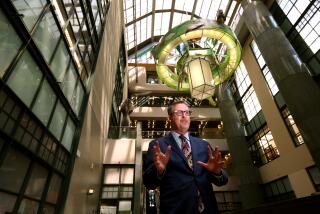ARCHITECTURE : British Library Controversy Riles Readers
LONDON — The bold idea was to create a new home for the British Library, the great repository of scholarly books and manuscripts whose precious possessions are scattered around this city.
The modern, angular, red-brick building was begun in 1982 at a then-estimated cost of $328 million. It was to employ the latest technology to consolidate the institution’s total 12-million-volume collection--including all the works now housed at the British Museum and available at the famed Round Reading Room--and to make it quickly accessible to readers.
The new library, in a seedy area next to London’s St. Pancras railway station, was to open in 1991 and was to be, in the soaring words of Executive Director Brian Lang, “a flagship building for one of the great pillars of civilization.”
It hasn’t turned out that way.
Through a combination of alleged mismanagement and muddle, the library’s construction has bled red ink, coming in now at a cost closer to $1 billion; its opening has been delayed until 1994 “at the earliest.” It will take longer to build than Christopher Wren took to build St. Paul’s Cathedral.
“A grand national statement has become a great national scandal,” said Brian Lake, secretary of the Regular Readers Group, which represents some 600 writers and scholars.
The latest holdup was the discovery that miles of a new, automated shelving and retrieval system have malfunctioned and rusted. Millions of books cannot be moved to the library’s subterranean floors until disputes over the system can be resolved.
The library’s construction has long been hampered by the national government’s piecemeal approach to funding the project. The government refused to pay for the original plan, forcing construction to proceed in stages.
Now the overall project, which would have concentrated books housed in 18 locations and several reading rooms, has been scaled back. The new main reading room, for instance, was to have 3,440 seats. But budget cuts have limited the number of places to only a few score more than the current seating capacity of 1,103 in scattered reading rooms.
“Serious government underfunding and management mishandling are responsible for the current chaotic state of affairs,” said writer Etrenne Lymbery, co-founder of the readers group, which has long opposed the massive project.
Meantime, Prince Charles, an amateur architectural critic, has attacked the library’s new brick building as “a dim collection of brick sheds groping for some symbolic significance. People will think that the Gothic St. Pancras (station) is the library and this is the new railway station.” He added that the building looks like “an academy for the secret police.”
Lang, the library director, said: “Delays are very worrying and frustrating. But it would be wrong to hold to provisional opening dates and jeopardize the need to have the service infrastructure firmly in place. Our new building is going to stand for centuries, and I am determined that we provide a first-class service from day one.”
The controversy has renewed the argument from many authors and scholars--including Sir Isaiah Berlin, Lord Beloff, Sir William Golding, Michael Foot, Dame Iris Murdoch, Harold Pinter, Tom Stoppard and Marina Warner--that the new library should not harm the famed Round Reading Room in the center of the British Museum in the nearby Bloomsbury district.
The 375-desk Round Reading Room has welcomed a stunning array of scholars under its Pantheon-like dome since its completion in 1857: Karl Marx and V. I. Lenin studied and worked there; so did Charles Dickens, Thomas Hardy, Arnold Bennett, Samuel Butler, George Bernard Shaw and W. B. Yeats.
Library annexes within the British Museum also contain such important artifacts as the Magna Carta, a Beowulf manuscript, a Gutenberg Bible, the Lindisfarne Gospel, the illuminated Book of Hours, the Earl of Essex’s death warrant, first folios of William Shakespeare, the last letter of British naval hero Lord Nelson and the manuscript of “Alice in Wonderland.”
Scholars, who argue for keeping the Round Reading Room, say that books dating before 1850 could be kept there, with newer volumes being moved to the St. Pancras site. As Foot said recently: “So many important writers have sat there and profited from the free entry. The current custodians have no right to go back on that.”
More to Read
Sign up for our Book Club newsletter
Get the latest news, events and more from the Los Angeles Times Book Club, and help us get L.A. reading and talking.
You may occasionally receive promotional content from the Los Angeles Times.







